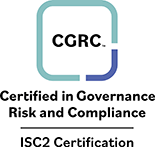We're open through the holidays to support your upskilling goals — Which training do you want to book?
We're open through the holidays to support your upskilling goals — Which training do you want to book?
Unable to find what you're searching for?
We're here to help you find itCertified in Governance, Risk and Compliance (CGRC) Course Overview
The Certified in Governance, Risk, and Compliance (CGRC) course is a comprehensive training program designed to equip learners with expert knowledge and skills in managing governance, risk, and compliance within an organization. It covers essential aspects of information security and privacy, addressing the creation and maintenance of a robust risk management program. Through the course, participants learn to understand and implement Regulatory and legal requirements, develop strategies for selecting and approving Security and privacy controls, and effectively assess and audit these controls.
Information security risk management is at the heart of Module 1, providing a foundation for the entire course. The course progresses through practical lessons on defining and categorizing information systems (Module 2), selecting appropriate security measures (Module 3), and implementing these measures (Module 4). Participants also gain proficiency in preparing and conducting assessments and audits (Module 5), authorizing information systems (Module 6), and engaging in Continuous monitoring (Module 7) to ensure ongoing compliance and risk mitigation.
By the end of the CGRC course, learners will have a thorough understanding of governance, risk management, and compliance practices, equipping them with the competencies needed to safeguard their organizations against evolving threats and to ensure adherence to relevant standards and regulations.
Successfully delivered 71 sessions for over 100 professionals
Purchase This Course
USD
View Fees Breakdown
| Course Fee | 2,450 |
| Exam Fee | 600 |
|
Total Fees (without exam) |
2,450 (USD) |
USD
View Fees Breakdown
| Course Fee | 1,850 |
| Exam Fee | 600 |
|
Total Fees (without exam) |
1,850 (USD) |
USD
View Fees Breakdown
| Flexi Video | 16,449 |
| Official E-coursebook | |
| Exam Voucher (optional) | |
| Hands-On-Labs2 | 4,159 |
| + GST 18% | 4,259 |
|
Total Fees (without exam & Labs) |
22,359 (INR) |
|
Total Fees (with Labs) |
28,359 (INR) |
Select Time
Select Date
| Day | Time |
|---|---|
|
to
|
to |
♱ Excluding VAT/GST
You can request classroom training in any city on any date by Requesting More Information
Inclusions in Koenig's Learning Stack may vary as per policies of OEMs
Scroll to view more course dates
You can request classroom training in any city on any date by Requesting More Information
♱ Excluding VAT/GST
*Inclusions in Koenig's Learning Stack may vary as per policies of OEMs
Certified in Governance, Risk and Compliance (CGRC)
Suggestion submitted successfully.
Koenig Learning Stack
Inclusions in Koenig's Learning Stack may vary as per policies of OEMs



